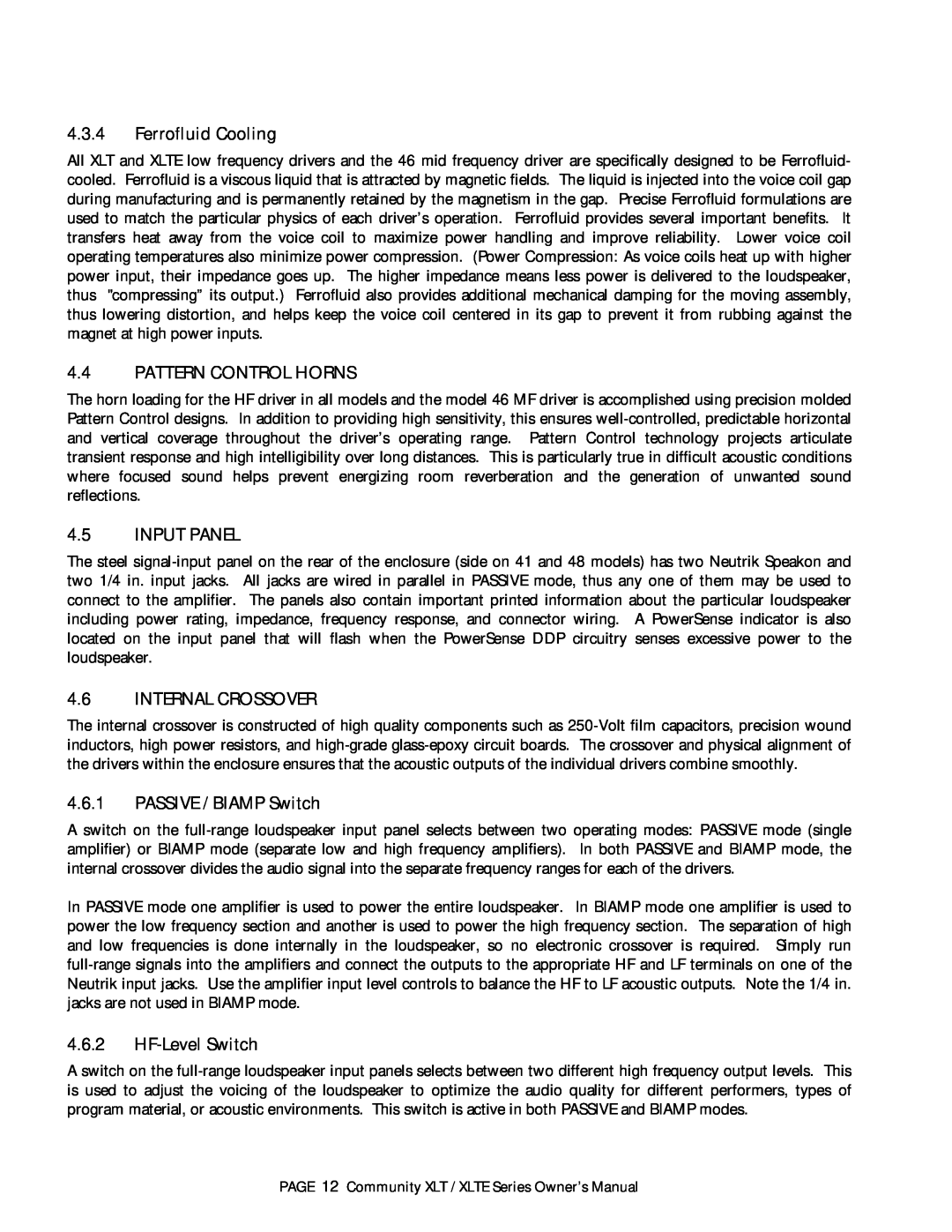4.3.4Ferrofluid Cooling
All XLT and XLTE low frequency drivers and the 46 mid frequency driver are specifically designed to be Ferrofluid- cooled. Ferrofluid is a viscous liquid that is attracted by magnetic fields. The liquid is injected into the voice coil gap during manufacturing and is permanently retained by the magnetism in the gap. Precise Ferrofluid formulations are used to match the particular physics of each driver’s operation. Ferrofluid provides several important benefits. It transfers heat away from the voice coil to maximize power handling and improve reliability. Lower voice coil operating temperatures also minimize power compression. (Power Compression: As voice coils heat up with higher power input, their impedance goes up. The higher impedance means less power is delivered to the loudspeaker, thus "compressing” its output.) Ferrofluid also provides additional mechanical damping for the moving assembly, thus lowering distortion, and helps keep the voice coil centered in its gap to prevent it from rubbing against the magnet at high power inputs.
4.4PATTERN CONTROL HORNS
The horn loading for the HF driver in all models and the model 46 MF driver is accomplished using precision molded Pattern Control designs. In addition to providing high sensitivity, this ensures well-controlled, predictable horizontal and vertical coverage throughout the driver’s operating range. Pattern Control technology projects articulate transient response and high intelligibility over long distances. This is particularly true in difficult acoustic conditions where focused sound helps prevent energizing room reverberation and the generation of unwanted sound reflections.
4.5INPUT PANEL
The steel signal-input panel on the rear of the enclosure (side on 41 and 48 models) has two Neutrik Speakon and two 1/4 in. input jacks. All jacks are wired in parallel in PASSIVE mode, thus any one of them may be used to connect to the amplifier. The panels also contain important printed information about the particular loudspeaker including power rating, impedance, frequency response, and connector wiring. A PowerSense indicator is also located on the input panel that will flash when the PowerSense DDP circuitry senses excessive power to the loudspeaker.
4.6INTERNAL CROSSOVER
The internal crossover is constructed of high quality components such as 250-Volt film capacitors, precision wound inductors, high power resistors, and high-grade glass-epoxy circuit boards. The crossover and physical alignment of the drivers within the enclosure ensures that the acoustic outputs of the individual drivers combine smoothly.
4.6.1PASSIVE / BIAMP Switch
A switch on the full-range loudspeaker input panel selects between two operating modes: PASSIVE mode (single amplifier) or BIAMP mode (separate low and high frequency amplifiers). In both PASSIVE and BIAMP mode, the internal crossover divides the audio signal into the separate frequency ranges for each of the drivers.
In PASSIVE mode one amplifier is used to power the entire loudspeaker. In BIAMP mode one amplifier is used to power the low frequency section and another is used to power the high frequency section. The separation of high and low frequencies is done internally in the loudspeaker, so no electronic crossover is required. Simply run full-range signals into the amplifiers and connect the outputs to the appropriate HF and LF terminals on one of the Neutrik input jacks. Use the amplifier input level controls to balance the HF to LF acoustic outputs. Note the 1/4 in. jacks are not used in BIAMP mode.
4.6.2HF-Level Switch
A switch on the full-range loudspeaker input panels selects between two different high frequency output levels. This is used to adjust the voicing of the loudspeaker to optimize the audio quality for different performers, types of program material, or acoustic environments. This switch is active in both PASSIVE and BIAMP modes.
